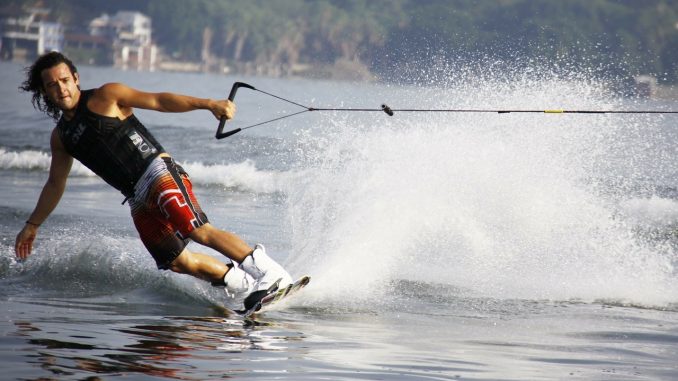
Wakeboarding involves strapping both of your feet to a single board and being towed across the surface of water. Wakeboarding is to water skiing what snowboarding is to skiing.
Skills – Strength: 6, Balance: 8, Flexibility: 4, Agility: 5, Coordination: 6
Time needed: travelling time + 1 hour, Cost to try: £50
What is Wakeboarding all About?
Traditionally, wakeboarding is done by being towed behind a speed boat, with you holding on tight to a handle attached to the end of a long rope. You gracefully perform wide sweeping turns and get some big air as you jump over the wake of the boat.
If you are familiar with boardsports, you shouldn’t have too much hassle getting the hang of wakeboarding
What do you Need to get Started in Wakeboarding?
To go wakeboarding, will need:
- A wet suit
- A wakeboard
- A buoyancy jacket
- A tow line
- Something to tow you, usually a speedboat
Once you have got your wetsuit and buoyancy jacket on, the next step is to sit on the edge of the jetty and put your feet into the rubber foot loops that are secured to the wakeboard. The general idea is that whatever happens, you will always stay attached to the wakeboard. It can be a bit of a challenge getting your feet in the foot loops, but at least you know you will stay attached to the wakeboard. Now comes the fun bit – the launch.
To launch on a wakeboard, you bob about in the water (thanks to your buoyancy jacket) with knees tucked up to your chest. The wakeboard floats, so you need to keep it out in front of you just in the water. You hold onto the handle at the end of the rope that is attached to the back of the speedboat. As the boat begins to pull you, you have to keep your arms straight in front of you and let your legs do the work of keeping the wakeboard just at the surface of the water in front of you. If you get it right, you extend your legs and you will soon be standing up. You then twist the wakeboard sideways so that the front end points forward, and away you go.
When you start out, you may experience a few variations on the launch:
- You can’t keep hold of the handle and let go. You have to just get a grip.
- You bend your arms and pull on the rope. This stops you from getting up and really tires you out. Keep your arms straight and let the rope pull you.
- Perpetual plough. You stay in the water, with the wakeboard ploughing in front of you.
- Sideslip. The board disappears off to one side and you end up going in.
- Dragging. You over balance forward and get dragged along face first. If this happens, let go!
- Nose dive. You put too much weight on your front foot and the wakeboard nose dives under the water, tipping you over.
One key tip I found is that unlike snowboarding, you have to keep your weight more on your back foot. With snowboarding, control is maintained by keeping weight over your front foot unless you find yourself in deep powder snow.
Wakeboarding Tows
You don’t need a speedboat to go wakeboarding.
There are more and more wakeboarding cable tow lines being setup at the edge of lakes. Look for wakeboard cable tow parks. This is like a long washing line with the tow rope fixed to it. The line moves under the control of a motor. An operator controls the speed, and looks after you. when you get to the end of the line, you have to learn how to turn to come back again. This is done by steering the wakeboard way out to one side, maintaining tension on the tow rope. This lets you perform a nice wide arc so you can turn around while the operator reverses the motor to begin pulling you back. It takes a few goes to crack it, but once you do you get such a kick because it means that you can just keep going.
People have used other things to tow wakeboards, such as cars, bikes or horses. The difficulty there is staying on the water without being dragged into the bank. Also, you have to make sure the rope doesn’t get caught in any bushes at the edge.
Wakeboarding Jumps and Tricks
Once you are up and away, you can happily follow the boat, grinning from ear to ear at your achievement with the wind in your hair. That is until you encounter the wake of the boat.
The wake is the V shaped wave that a boat makes as it moves through the water. When you are behind the boat, it is reasonably calm water. As you learn to move left and right, you will have to cope with crossing the waves. This can be exhilarating, as you can get to jump if you try. the faster you cross the wake, the more air you can catch on your jump.
Find out more about Wakeboarding
The best place to find out more about wakeboarding is from the British Water Ski and Wakeboard website.
